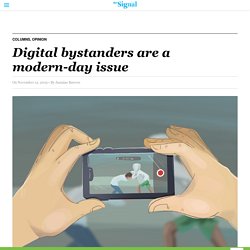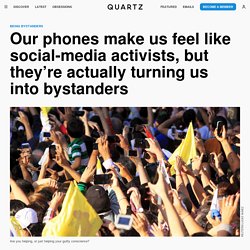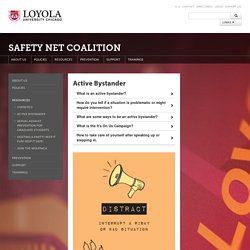

What Is the Bystander Effect? Causes of Bystander Effect. Quote by Elie Wiesel. Digital bystanders are a modern-day issue - The Signal. While on your way to Classroom South, an argument breaks out right in front of you between two people.

The argument then escalates into a fistfight, and you continue to stand there and observe. At that moment, you were a bystander. A bystander is a person who is present at an event or incident but does not take part.. Being a bystander can often lead to something called the bystander effect, which occurs when no one witnessing an event does anything to help because they see that others aren’t helping or assume in their head that those people have already helped. Seeing others not doing anything discourages them from doing something. The bystander effect is being made worse by people filming violent events on their smartphones. On April 9, 2017, a video of a man being dragged off a United Airlines flight was posted on the internet and went viral.

But I don’t need to tell you that. Each of your most outspoken Facebook friends probably posted about the event, highlighting the aspects of it that best reinforced their worldview. The incident was covered all over American media and even sparked outrage in China. The collective focus may have now moved on to its next source of outrage, but there was something that only a few people noticed in the moment: a plane full of quiet passengers. Other than one woman screaming, hardly anyone else on the plane seemed bothered enough by what was happening to raise a ruckus. Instead of intervening in the assault, the passengers stoically took out their cameraphones and pointed them toward David Dao, whose body was dragged along the aisle of the airplane, glasses askew, face bloody, and belly exposed.
Khaseen Morris: Teen held for killing that bystanders filmed. Image copyright Nassau County Police A New York teenager has been charged with the fatal stabbing of a 16-year-old boy whom bystanders filmed bleeding to death.

Tyler Flach, 18, is accused of second-degree murder in the deadly after-school brawl that broke out not far from the victim's Long Island school. Police said that most of the "50, 60, 70" kids who witnessed the attack on Khaseen Morris did nothing to stop it. "That's egregious," said Detective Lt Stephen Fitzpatrick. "Kids stood here and didn't help Khaseen," Lt Fitzpatrick said. Police were called to a row of shops near Oceanside High School in Nassau County on Monday afternoon. Mr Fitzpatrick said the fight, which took place outside a pizzeria, was a "pre-arranged dispute" over a girl. Police say the main suspect and six or seven other assailants charged at Khaseen, who was unarmed.
Glued to our phones. 10 Notorious Cases of the Bystander Effect. The bystander effect is the somewhat controversial name given to a social psychological phenomenon in cases where individuals do not offer help in an emergency situation when other people are present. The probability of help has in the past been thought to be inversely proportional to the number of bystanders.
In other words, the greater the number of bystanders, the less likely it is that any one of them will help. This list describes the prototype of the effect and cites nine particularly heinous examples. The Parable of The Good Samaritan First, the prototype of the bystander effect. Jesus then explains, with the following parable, that everyone is everyone’s neighbor, and that help should be offered to anyone in need of it, regardless of who or what that person is. A Jew is going along the road, and is beset by bandits, who beat him severely, strip his clothes, and rob him. The Bystander Effect:The Death of Kitty Genovese. The Murder of Kitty Genovese.
Bystander Intervention In Emergencies: Diffusion Of Responsibility. Overcoming the Bystander Effect. Active Bystander: Safety Net Coalition: Loyola University Chicago. Be direct.

Address the person being targeted or the problematic behavior directly. Things you can say to the person being targeted: “Do you need help?” “Do you want me to call someone for you?” “What can I do to help you?” “Can I walk you home?” Things you can say to the person acting not so good: “What you said earlier really bothered me...” Removing someone from a risky situation works as a way to directly intervene too. Distract. Delegate. Active bystander. Active Bystander. Overcoming bystander effect. Bystander effect1. From Empathy to Apathy: The Bystander Effect Revisited - Ruud Hortensius, Beatrice de Gelder, 2018. When people are asked whether they would spontaneously assist a person in an emergency situation, almost everyone will reply positively.

Although we all imagine ourselves heroes, the fact is that many people refrain from helping in real life, especially when we are aware that other people are present at the scene. In the late 1960s, John M. Darley and Bibb Latané (1968) initiated an extensive research program on this so-called “bystander effect.” In their seminal article, they found that any person who was the sole bystander helped, but only 62% of the participants intervened when they were part of a larger group of five bystanders. Following these first findings, many researchers consistently observed a reduction in helping behavior in the presence of others (Fischer et al., 2011; Latané & Nida, 1981).